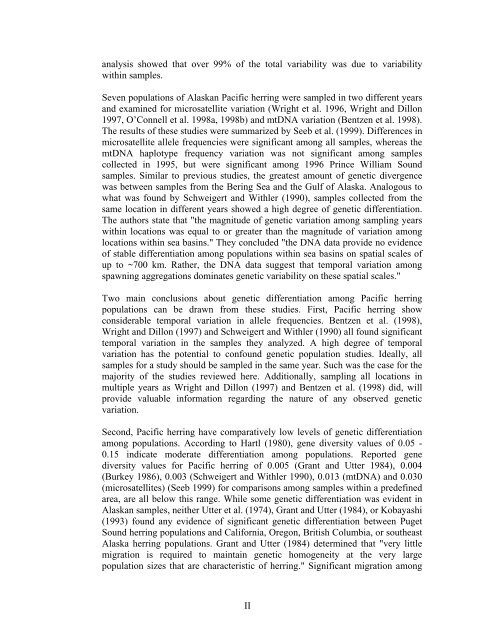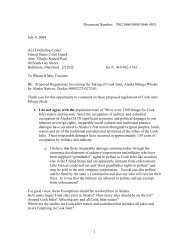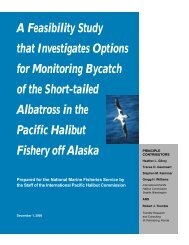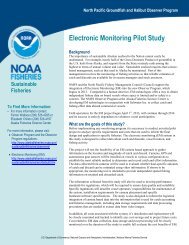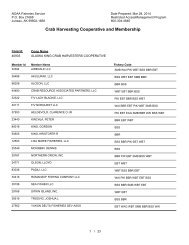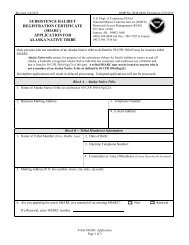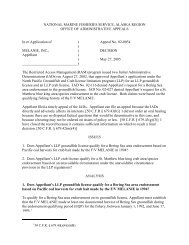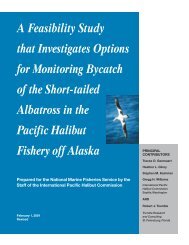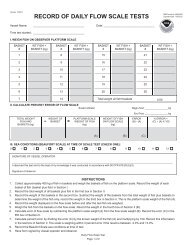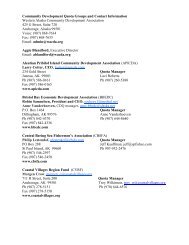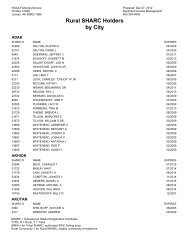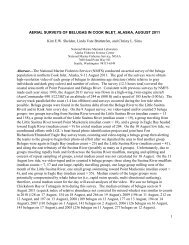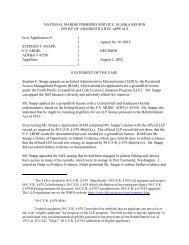Petition to List Lynn Canal Pacific Herring under the Endangered ...
Petition to List Lynn Canal Pacific Herring under the Endangered ...
Petition to List Lynn Canal Pacific Herring under the Endangered ...
You also want an ePaper? Increase the reach of your titles
YUMPU automatically turns print PDFs into web optimized ePapers that Google loves.
analysis showed that over 99% of <strong>the</strong> <strong>to</strong>tal variability was due <strong>to</strong> variability<br />
within samples.<br />
Seven populations of Alaskan <strong>Pacific</strong> herring were sampled in two different years<br />
and examined for microsatellite variation (Wright et al. 1996, Wright and Dillon<br />
1997, O’Connell et al. 1998a, 1998b) and mtDNA variation (Bentzen et al. 1998).<br />
The results of <strong>the</strong>se studies were summarized by Seeb et al. (1999). Differences in<br />
microsatellite allele frequencies were significant among all samples, whereas <strong>the</strong><br />
mtDNA haplotype frequency variation was not significant among samples<br />
collected in 1995, but were significant among 1996 Prince William Sound<br />
samples. Similar <strong>to</strong> previous studies, <strong>the</strong> greatest amount of genetic divergence<br />
was between samples from <strong>the</strong> Bering Sea and <strong>the</strong> Gulf of Alaska. Analogous <strong>to</strong><br />
what was found by Schweigert and Withler (1990), samples collected from <strong>the</strong><br />
same location in different years showed a high degree of genetic differentiation.<br />
The authors state that "<strong>the</strong> magnitude of genetic variation among sampling years<br />
within locations was equal <strong>to</strong> or greater than <strong>the</strong> magnitude of variation among<br />
locations within sea basins." They concluded "<strong>the</strong> DNA data provide no evidence<br />
of stable differentiation among populations within sea basins on spatial scales of<br />
up <strong>to</strong> ~700 km. Ra<strong>the</strong>r, <strong>the</strong> DNA data suggest that temporal variation among<br />
spawning aggregations dominates genetic variability on <strong>the</strong>se spatial scales."<br />
Two main conclusions about genetic differentiation among <strong>Pacific</strong> herring<br />
populations can be drawn from <strong>the</strong>se studies. First, <strong>Pacific</strong> herring show<br />
considerable temporal variation in allele frequencies. Bentzen et al. (1998),<br />
Wright and Dillon (1997) and Schweigert and Withler (1990) all found significant<br />
temporal variation in <strong>the</strong> samples <strong>the</strong>y analyzed. A high degree of temporal<br />
variation has <strong>the</strong> potential <strong>to</strong> confound genetic population studies. Ideally, all<br />
samples for a study should be sampled in <strong>the</strong> same year. Such was <strong>the</strong> case for <strong>the</strong><br />
majority of <strong>the</strong> studies reviewed here. Additionally, sampling all locations in<br />
multiple years as Wright and Dillon (1997) and Bentzen et al. (1998) did, will<br />
provide valuable information regarding <strong>the</strong> nature of any observed genetic<br />
variation.<br />
Second, <strong>Pacific</strong> herring have comparatively low levels of genetic differentiation<br />
among populations. According <strong>to</strong> Hartl (1980), gene diversity values of 0.05 -<br />
0.15 indicate moderate differentiation among populations. Reported gene<br />
diversity values for <strong>Pacific</strong> herring of 0.005 (Grant and Utter 1984), 0.004<br />
(Burkey 1986), 0.003 (Schweigert and Withler 1990), 0.013 (mtDNA) and 0.030<br />
(microsatellites) (Seeb 1999) for comparisons among samples within a predefined<br />
area, are all below this range. While some genetic differentiation was evident in<br />
Alaskan samples, nei<strong>the</strong>r Utter et al. (1974), Grant and Utter (1984), or Kobayashi<br />
(1993) found any evidence of significant genetic differentiation between Puget<br />
Sound herring populations and California, Oregon, British Columbia, or sou<strong>the</strong>ast<br />
Alaska herring populations. Grant and Utter (1984) determined that "very little<br />
migration is required <strong>to</strong> maintain genetic homogeneity at <strong>the</strong> very large<br />
population sizes that are characteristic of herring." Significant migration among<br />
II


